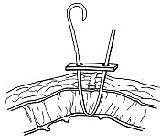|
CORONARY OCCLUSION |
|
With CPB, a clear anastomotic site is obtained
by cross-clamping the aorta, which stops all blood flow through
the coronary arteries. In beating heart CABG, only proximal occlusion
of the target coronary artery is required. Distal occlusion has
not been found to be necessary unless poor visibility jeopardizes
the precision of the anastomosis.
|
| "Vessel occlusion is important from an antegrade flow perspective. We use a specially designed, very short-nosed bulldog." 13 -David Perkowski, M.D. |
|
Many techniques for coronary artery occlusion are currently being used in conjunction with stabilization technology to prevent coronary trauma. In the following technique, a pledget and silastic tape are used to apply occlusion pressure (Figure 9): 1. Place pledgeted silastic tape around the coronary artery. 2. Perform the arteriotomy while blood is flowing through the artery in order to minimize the risk of perforating the back wall of the artery. 3. Slide the pledget down while gently pulling up on the silastic
tape just to the point of hemostasis. 4. Place a small titanium ligaclip on the silastic tape to maintain the occlusion.
|
 Figure 9. Coronary occlusion with silastic tape and pledget |
| VISUALIZATION/BLOODLESS FIELD |
|
In order to effectively perform an anastomosis on a coronary artery, whether or not the heart is beating, the anastomotic site must be cleared of blood to allow visualization for accurate suturing. Several visualization devices are available on the market because
a perfectly bloodless field is rare in beating heart CABG.
|
| "It is critical to have an assistant who understands the use of the humidified CO2 jet so you can see each suture."13 -James C. Hart, M.D. |
| "We also use a blower/mister to clear the field of any other blood that's coming retrograde. It is essential. You can't do [beating heart CABG] without having a blower/mister."13 -David Perkowski, M.D. |


